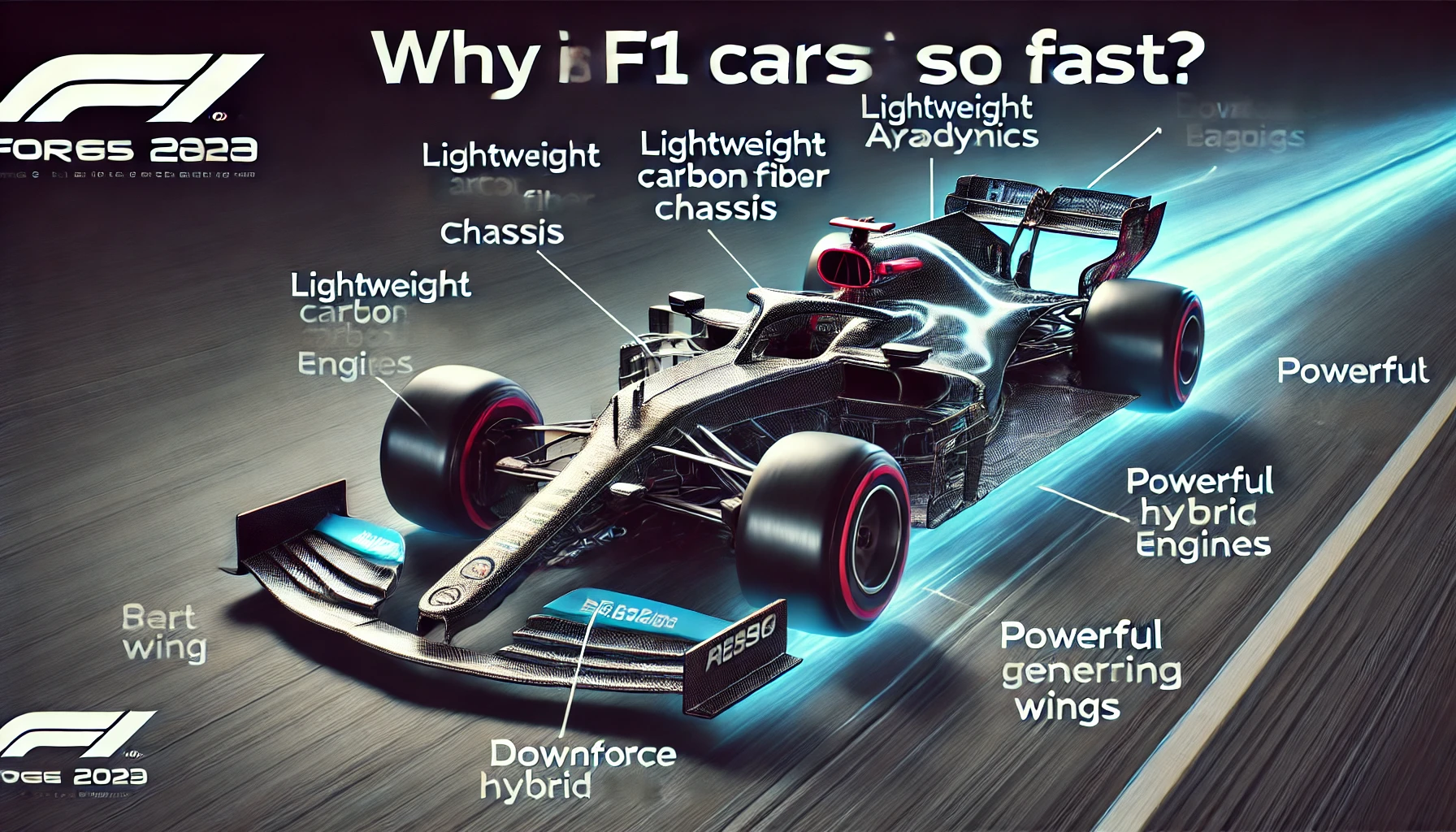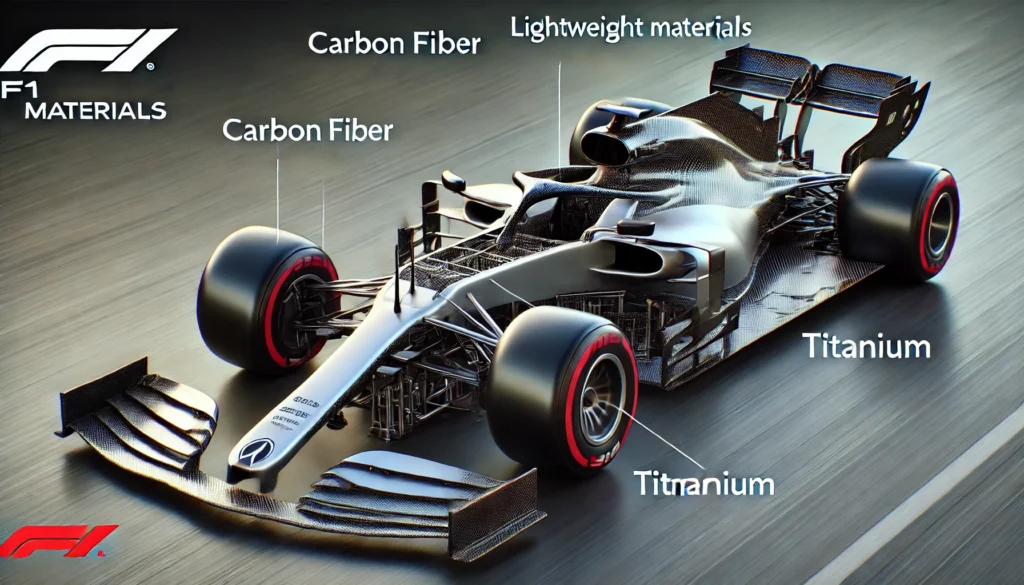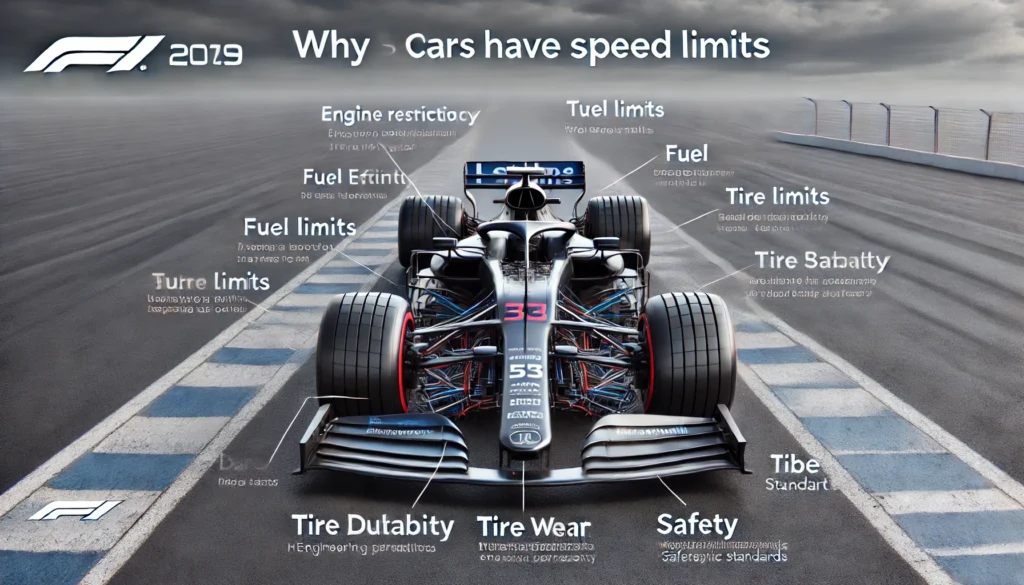It is said that F1 racing is some of the most exciting in the world. It shows off the world’s fastest cars and drivers. What are the top speeds for a non-confined controlled Formula One car? This is a question that all F1 fans and people in general are interested in. After hearing about the crazy speeds these cars can reach, your next question will be what lets them go that fast.
We’re going to talk more about these two interesting questions in this blog post. This piece will look at the top speed of an F1 car in its most basic form. It will also talk about the physics and science behind these machines’ lightning-fast speeds and the many factors that contribute to their incredible speed. Peri Are you interested in F1 or just want to know more about the cars? This post is for you.
How Fast Can an F1 Car Go? Breaking Down the Numbers
In order to understand how fast F1 cars can go, I mean what is the top speed of an F1 car; we need to consider a few speed-related metrics. F1 speed is not about top-speed on a straight track it relies heavily upon cornering velocity too. Fast acceleration, higher cornering and fastest stoppage all carry significant weight. Here are the figures:

Top Speed of an F1 Car
Speed conjures the image of top speed what a vehicle can achieve at its utmost limit on a flat straight track in most peoples’ minds. Top speeds are a regular feature of an F1 car. The fastest speed ever recorded within a Formula 1 car as of the year is 231. It moves faster than a commercial jet during takeoff and is more than three times the speed limit of most highways!
Don’t expect those speeds to be hit at every race, F1 cars usually travel upwards of 300-350 km/h (186-217 mph) on long straights depending upon the circuit. For example, the long straights of circuits such as Monza a circuit considered the “Temple of Speed” due to it’s straights which enable cars to reach maximum speed over an entire race.
Acceleration
Of course, top-speed is only one step in the phased approach. In Formula 1, acceleration is as crucial. Being able to accelerate from 0-speed in seconds could mean the difference between you crossing that finishing line, or losing it. The 0-100 km/h (62 mph) sprint takes around just a couple seconds… as fast as an F1 car! ); by way of comparison, a Ferrari or Lamborghini — two of the quickest road cars in existence today would need between 3 and 4 seconds to do the same; even off an aircraft carrier deck where most jet fighters can travel more than five times faster than any road car on record it still takes many fighter jets several seconds just to reach speeds above 100 km/h.
The explosive acceleration a Formula 1 car provides is fundamental to fast getaways at the race’s start, and also allows bursts of speed in overtaking situations.
Cornering Speed
The apex of F1 car performance characteristics is their cornering speed, and this could be the most visible oneüzüm. While normal road cars are not designed to corner at very high speeds, F1 machines maintain these kinds of speed throughout a circuit.

F1 cars are capable of pulling 5g lateral acceleration, which means can take a corner at speeds between 150-250 km/h (93-155 mph) without losing grip.
In similar corners on Circuit de Barcelona-Catalunya hillclimb, most road cars battle with keeping their tyres gripped above 80-100 km/h (50-62 mph). Not only is this extreme here because of the design, but it’s exactly what allows F1 to be so awesome to watch–you can literally see a driver take his car up and over that line into rage-on-the-limit mode.
Braking
Braking is a very underrated piece of the puzzle that goes in to speed, but it’s just as key as being able to light up your tyres. The F1 cars feature carbon fiber brakes capable of bringing the car from 200 km/h (124 mph) to zero in less than three seconds. This type of braking is especially important for cars coming off high-speed straights and into sharp turns.
An F1 car will decelerate from 306 to zero km/h in just over four seconds — about five times faster than many standard road cars. And crucially, it achieves this while maintaining the chassis balance and composure needed for the next move, thanks largely (again) to its remarkable braking power.
Why Are F1 Cars So Fast? Engineering Behind the Speed
Now that we’ve looked at the raw numbers, it’s time to explore why F1 cars can reach such impressive speeds. The answer lies in a combination of cutting-edge technology, world-class engineering, and finely tuned mechanics. Let’s break down the major factors:

1. Aerodynamics: The Key to Downforce and Speed
One of the primary reasons F1 cars are so fast is their aerodynamic design. F1 engineers spend countless hours perfecting the shape of the car to minimize air resistance (drag) while maximizing downforce.
- Downforce is the force that pushes the car down onto the track, helping it maintain traction at high speeds. The more downforce a car generates, the faster it can go through corners without losing grip.
- Drag is the resistance a car faces as it moves through the air. Reducing drag is critical to maximizing top speed on straights.
F1 cars feature an intricate array of wings, diffusers, and other aerodynamic elements that help strike the perfect balance between downforce and drag. For example, the front and rear wings of the car are designed to direct airflow in a way that increases downforce while minimizing drag. This allows the car to “stick” to the track at high speeds without sacrificing too much velocity on straights.
Ground Effect is another aerodynamic trick F1 cars use. This phenomenon occurs when air passes under the car at high speeds, creating a vacuum that pulls the car closer to the ground. The result is even more downforce, allowing the car to corner faster without relying on larger, more drag-inducing wings.
2. Lightweight Materials: Speed Through Efficiency
Another factor contributing to the speed of F1 cars is their use of lightweight materials. Every component of an F1 car is engineered to be as light as possible without compromising strength or safety.

- Carbon fiber is the material of choice for F1 cars. It’s incredibly strong, durable, and, most importantly, lightweight. The chassis, wings, and even the steering wheel are made from carbon fiber to keep the car’s weight down to a minimum. A modern F1 car weighs about 795 kg (1,753 lbs), including the driver and fluids.
- Titanium and other high-performance alloys are used for various mechanical parts like suspension and engine components, offering the perfect balance between strength and weight.
The lighter the car, the less energy it takes to accelerate, brake, and corner. This is a fundamental reason why F1 cars can achieve such mind-boggling speeds.
3. Power Units: Turbocharged Hybrids
The power unit (PU) of an F1 car is one of the most technologically advanced engines in the world. Since 2014, F1 cars have used hybrid power units that combine traditional internal combustion engines with electric motors to maximize performance while minimizing fuel consumption.
Here’s how it works:
- Internal Combustion Engine (ICE): F1 cars are powered by a 1.6-liter turbocharged V6 engine that can produce over 1,000 horsepower. While the engine size may seem small, it’s designed to operate at incredibly high speeds—reaching up to 15,000 RPM.
- Energy Recovery Systems (ERS): F1 cars use two types of ERS systems to capture energy that would otherwise be wasted during braking and acceleration:
- The MGU-H captures energy from the heat of the exhaust.
- The MGU-K captures kinetic energy during braking.
This recovered energy is stored in a battery and can be deployed to give the car a power boost during critical moments in the race.
Together, these components form a hybrid power unit that allows F1 cars to achieve both incredible speeds and remarkable fuel efficiency. In fact, despite the immense power they produce, F1 engines are among the most fuel-efficient in the world—able to complete an entire race using just 100 kg of fuel (approximately 130 liters or 34 gallons).
4. Tires: The Perfect Balance Between Grip and Speed
Tires are another critical component in the quest for speed. F1 tires are designed to operate at extremely high temperatures, providing maximum grip on the track.
- Slick tires (tires without tread) offer the highest possible grip on dry tracks because there’s more rubber in contact with the surface.
- Wet tires are used when the track is wet, featuring grooves to channel water away and reduce the risk of hydroplaning.

Tire management is crucial in F1, as the tires are the only point of contact between the car and the track. Engineers and drivers work together to find the optimal tire pressure and temperature to ensure the best performance throughout the race.
The Role of the Driver: Harnessing the Speed
While the engineering and technology behind F1 cars are crucial, the driver’s skill plays an equally important role. Even with the fastest car on the grid, success in F1 requires incredible talent, precision, and split-second decision-making. Let’s explore the qualities that allow F1 drivers to make the most of their machines.
Reaction Times and Reflexes
An F1 driver’s reaction time is one of their most valuable assets. When you’re traveling at over 300 km/h, even the smallest mistake can have catastrophic consequences. Drivers must have lightning-fast reflexes to avoid collisions, make overtakes, and adjust to changing track conditions.
Physical Fitness
It might be surprising, but F1 drivers are some of the fittest athletes in the world. Driving an F1 car puts incredible strain on the body, especially
What Makes F1 Cars Go So Fast?
The speed of an F1 car is the result of a combination of advanced engineering, cutting-edge technology, and precision tuning. Several key factors contribute to their incredible velocity:
1. Aerodynamics: Maximizing Downforce and Reducing Drag
- Downforce: F1 cars are designed to generate as much downforce as possible, which pushes the car onto the track and allows it to maintain high speeds, especially through corners. The wings, diffusers, and bodywork are all optimized to increase downforce without significantly increasing drag.
- Drag Reduction: F1 engineers strive to reduce aerodynamic drag—the resistance a car faces as it moves through the air. To help with this, the cars feature adjustable wings and other aerodynamic components that allow for optimal air management.
2. Power Units: Hybrid Turbocharged Engines
- The heart of an F1 car is its 1.6-liter V6 turbocharged hybrid engine, capable of producing over 1,000 horsepower. Despite the small size, the engine is highly efficient and can rev up to 15,000 RPM. It’s paired with Energy Recovery Systems (ERS), which capture and store energy from braking and exhaust heat, giving the car an additional power boost during acceleration.
3. Lightweight Construction
- F1 cars are built from materials like carbon fiber and titanium to reduce weight while maintaining strength and safety. A lighter car means better acceleration, braking, and overall handling.
4. Tires and Grip
- The slick tires used in F1 racing provide exceptional grip, especially on dry tracks. This enables the car to maintain high speeds through corners without slipping or losing control.
5. Advanced Suspension Systems
- F1 cars use highly sophisticated suspension systems that keep the car stable at high speeds and allow for better cornering. These systems ensure that the tires maintain maximum contact with the track, improving traction and control.
6. Driver Skill and Strategy
- While the car itself is an engineering marvel, it takes an exceptional driver to harness its full potential. F1 drivers have to manage the car’s systems, maintain optimal tire performance, and react to split-second changes on the track, all while maintaining incredible speeds.
Why Are F1 Cars Speed Limited?
While F1 cars are built for speed, several factors limit how fast they can go. Some of these limitations are due to safety concerns, while others are a result of regulatory decisions by the sport’s governing body, the FIA (Fédération Internationale de l’Automobile).

1. Safety Considerations
- High-Speed Risks: The faster an F1 car goes, the greater the risk of catastrophic accidents. Both driver and spectator safety are primary concerns, and limiting top speeds reduces the likelihood of fatal crashes.
- Braking and Cornering: F1 cars already travel at incredible speeds on straights, but high-speed cornering presents significant dangers. Limits on top speeds help ensure that drivers can still safely navigate tight corners and chicanes.
2. Track Design
- Not all F1 tracks are built for ultra-high-speed racing. Some circuits, like Monaco, have narrow roads and sharp turns, making it impossible for cars to reach their maximum speeds. Other tracks feature long straights where cars can go faster, but still within safe limits.
3. Regulations to Ensure Competitive Racing
- The FIA imposes regulations on car design, engine power, and aerodynamic components to maintain competitive balance across teams. Limiting engine power and adjusting aerodynamics through regulations like Drag Reduction Systems (DRS) help ensure that no one team has an unfair speed advantage.
4. Environmental Concerns
- As part of F1’s push toward sustainability, the FIA has introduced limits on fuel consumption and emissions. Modern F1 cars use hybrid power units to be more fuel-efficient, which can limit how much raw power they can generate over the course of a race.
5. Engine Longevity and Costs
- F1 teams are limited in the number of engines they can use throughout the season. As a result, teams often restrict how hard they push the engine during races to avoid excessive wear and potential penalties. This indirectly limits the maximum speed of the cars during the race.
Conclusion: The Essence of F1 Speed
The aerodynamics, hybrid engines and lightweight materials that make F1 cars go so fast allow them to hit 370 km/h (if not for safety restraints). But there are some limits on speed — regulations require drivers remain below certain laps times at tracks around the world to keep everyone safe and track designs must take into account environmental effects. This makes for exciting, fair races without compromising the safety of drivers and spectators. In the end it is this engineering/strategy combination that keeps F1 ahead as the world’s fastest and sexiest form of racing.
FAQs
How fast can F1 cars go?
F1 cars can reach speeds of over 220 mph (354 km/h), depending on the track and race conditions.
What is the fastest recorded speed in F1?
The fastest recorded speed is 231.4 mph (372.6 km/h) by Valtteri Bottas in 2016 during the Mexican Grand Prix.
What engines do F1 cars use?
F1 cars use 1.6L V6 turbo hybrid engines that combine power and efficiency, contributing to their remarkable speed.
Why are F1 cars so fast?
F1 cars are fast due to their advanced aerodynamics, lightweight design, powerful engines, and cutting-edge technology.

 Blog
Blog